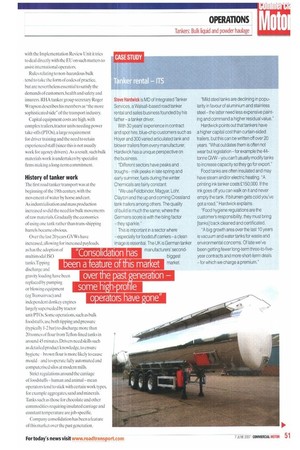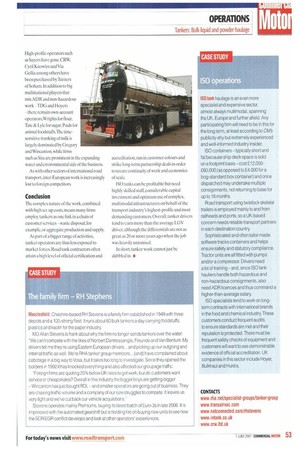UNDER PRESS
Page 50

Page 51

Page 53

If you've noticed an error in this article please click here to report it so we can fix it.
The tanker market is going through a tough time as it faces increasing amounts of red
tape and competition from Continental Europe. Dave Young reports. Tanker work is one of the most heavily regulated sectors of road haulage. Even non-ADR bulk Liquid and powder carriage the focus of this feature must comply with a lot of legislation.
Helping members influence and adhere to both national and EU statutes forms a significant part of the work of the Road Haulage Association (RHA) tanker group, which also has the difficult task of enlisting the support of customers in changing working practices and equipment to accommodate new laws. A current example is the RHA's work with the dairy industry to allow bottom loading, improving health and safety by removing the need for drivers to climb on tanks.
It is very hard to retrospectively change legislation, so the tanker group talks to a range of government departments and industry bodies-such as the MT, Highways Agency and Vosa about developments in regulations, vehicle equipment, construct ion and design and operational performance to identify possible problems at the planning stage. Along with the Implementation Review Unit it tries to deal directly with the EU on such matters to assist international operators.
Rules relating to non-hazardous bulk . tend to take the form of codes of practice, but are nevertheless essential to satisfy the demands of customers, health and safety and insurers. RHA tanker group secretary Roger Wrapson describes his members as "the more sophisticated side" of the transport industry Capital equipment costs are high, with complex trailers, tractor units needing power take-offs (PT0s), a large requirement for driver training and the need to retain experienced staff (since this is not usually work for agency drivers). As a result, such bulk materials work is undertaken by specialist firms making a long-term commitment.
History of tanker work
The first road tanker transport was at the beginning of the 19th century, with the movement of water by horse and cart. As industrialisation and mass production increased so did the need for bulk movements of raw materials. Gradually the economies of using one tank rather than trans-shipping barrels became obvious.
Over the last 20 years GVWs have increased, al lowing for increased payloads, as has the adoption of multimc.)dal ISO tanks.Tipping discharge and gravity loading have been replaced by pumping or blowing equipment (eg Transairvac) and independent donkey engines largely superseded by tractor unit PT0s. Some operations, such as bulk foodstuffs, use both tipping and pressure (typically 1-2 bar) to discharge more than 20 tonnes of flour from Teflon-lined tanks in around 45 minutes. Drivers need skills such as detailed product knowledge, to ensure hygiene brown flour is more likely to cause mould and to operate fully automated and computerised silos at modern mills.
Strict regulations around the carriage of foodstuffshuman and animal-mean operators tend to stick with certain work types, for example aggregates, sand and minerals. Tanks such as those for chocolate and other commodities requiring insulated carriage and constant temperature are job-specific.
Company consolidation has been a feature of this market over the past generation.
"Consolidation een a feature oft
High-profile operators such as Sayers have gone. CRW, Cyril Knowles and Via Gellia among others have been purchased byTurners of Soham. In addition to big multinational players that mix ADR and non-hazardous work -TDG and Hoyers -there remain own-account operators,Wrights for flour, Tate & Lyle for sugar. Pa uls for animal foodstuffs.The limesensitive trunking of milk is largely dominated by Gregory and Wincanlon, while firms such as Sita are prominent in the expanding water and environmental side of the business.
As with other sectors of international road transport, inter-European work is increasingly lost to foreign competitors.
Conclusion
The complex nature of the work, combined with high set-up costs, means many firms employ tankers as one link in a chain of customer services waste disposal, for example, or aggregate production and supply.
As part of a bigger range of activities, tanker operators are thus less exposed to market forces. Road tank contractors often attain a high level of official certification and accreditation, run in customer colours and strike long-term partnership deals in order to secure continuity of work and economies of scale.
ISO tanks can be profitable but need highly skilled staff, considerable capital investment and optimum use of complex, multimodal infrastructures on behalf of the transport industry's highest-profile and most demanding customers. Overall, tanker drivers tend to earn more than the average LGV driver, although the differentials are not as great as 20 or more years ago when the job was heavily unionised.
In short, tanker work cannot just he dabbled in.






















































































































































































